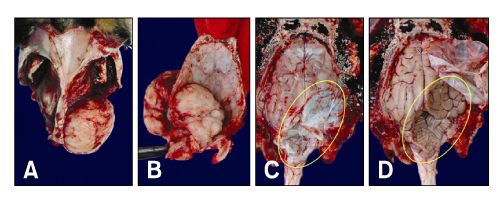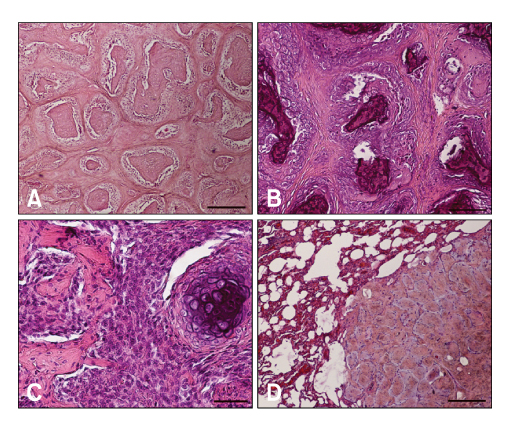J Vet Sci.
2009 Mar;10(1):81-83. 10.4142/jvs.2009.10.1.81.
Multilobular tumour of the caudal cranium causing severe cerebral and cerebellar compression in a dog
- Affiliations
-
- 1Pathology Laboratory, Faculty of Veterinary Medicine, Aristotle University, 54124 Thessaloniki, Greece. plouk@vet.auth.gr
- 2Diagnostic Laboratory, Faculty of Veterinary Medicine, Aristotle University, 54124 Thessaloniki, Greece.
- KMID: 1089351
- DOI: http://doi.org/10.4142/jvs.2009.10.1.81
Abstract
- Multilobular tumour of bone (MTB) is an uncommon tumour and is usually located in the skull. A 13-year-old mixed breed dog was presented with a two-week history of progressively worsening vestibular dysfunction and cognitive abnormalities; it appeared demented and showed asymmetric ataxia and hypermetria of all limbs. The owner opted to have the animal euthanised. Necropsy revealed a large mass occupying the right occipital, parietal and temporal bones, severely compressing the cerebellum and the right occipital lobe. Histologically, it was characterised by the presence of multiple lobules containing osteoid or cartilage and separated by fibrous septae, features typical of MTB. Lung metastases were evident. To our knowledge, this is the first report of an MTB causing both severe cerebral and cerebellar compression and the second detailed report of an MTB of the occipital bone. MTB should be included in the differential diagnosis of bone tumours as well as in cases with central vestibular disease.
Keyword
MeSH Terms
Figure
Reference
-
1. Banks TA, Straw RC. Multilobular osteochondrosarcoma of the hard palate in a dog. Aust Vet J. 2004. 82:409–412.
Article2. Dernell WS, Straw RC, Cooper MF, Powers BE, LaRue SM, Withrow SJ. Multilobular osteochondrosarcoma in 39 dogs: 1979-1993. J Am Anim Hosp Assoc. 1998. 34:11–18.
Article3. Hanley CS, Gieger T, Frank P. What is your diagnosis? Multilobular osteoma (MLO). J Am Vet Med Assoc. 2004. 225:1665–1666.4. Hathcock JT, Newton JC. Computed tomographic characteristics of multilobular tumor of bone involving the cranium in 7 dogs and zygomatic arch in 2 dogs. Vet Radiol Ultrasound. 2000. 41:214–217.
Article5. Jacobson SA. The Comparative Pathology of the Tumors of Bone. 1971. Springfield: Thomas;102–109.6. Kim H, Nakaichi M, Itamoto K, Taura Y. Primary chondrosarcoma in the skull of a dog. J Vet Sci. 2007. 8:99–101.
Article7. Lange AL, Stogdale L. Chondroma rodens in a dog. J S Afr Vet Assoc. 1978. 49:60–65.8. Lipsitz D, Levitski RE, Berry WL. Magnetic resonance imaging features of multilobular osteochondrosarcoma in 3 dogs. Vet Radiol Ultrasound. 2001. 42:14–19.
Article9. Losco PE, Diters RW, Walsh KM. Canine multilobular osteosarcoma of the skull with metastasis. J Comp Pathol. 1984. 94:621–624.
Article10. Loukopoulos P, Thornton JR, Robinson WF. Clinical and pathologic relevance of p53 index in canine osseous tumors. Vet Pathol. 2003. 40:237–248.
Article11. McCalla TL, Moore CP, Turk J, Collier LL, Pope ER. Multilobular osteosarcoma of the mandible and orbit in a dog. Vet Pathol. 1989. 26:92–94.
Article12. Moissonnier P, Devauchelle P, Delisle F. Cranioplasty after en bloc resection of calvarial chondroma rodens in two dogs. J Small Anim Pract. 1997. 38:358–363.
Article13. Pakhrin B, Bae IH, Jee H, Kang MS, Kim DY. Multilobular tumor of the mandible in a Pekingese dog. J Vet Sci. 2006. 7:297–298.
Article14. Pirkey-Ehrhart N, Withrow SJ, Straw RC, Ehrhart EJ, Page RL, Hottinger HL, Hahn KA, Morrison WB, Albrecht MR, Hedlund CS, Hammer AS, Holmberg DL, Moore AS, King RR, Klausner JS. Primary rib tumors in 54 dogs. J Am Anim Hosp Assoc. 1995. 31:65–69.
Article15. Slayter MV, Boosinger TR, Pool RR, Dammrich K, Misdorp W, Larsen S. Histological Classification of Bone and Joint Tumors of Domestic Animals. 1994. Washington DC: Armed Forces Institute of Pathology;1–50.16. Straw RC, LeCouteur RA, Powers BE, Withrow SJ. Multilobular osteochondrosarcoma of the canine skull: 16 cases (1978-1988). J Am Vet Med Assoc. 1989. 195:1764–1769.17. Thompson KG, Pool RR. Meuten DJ, editor. Tumors of bones. Tumors in Domestic Animals. 2002. 4th ed. Ames: Iowa State University Press;296–298.
Article
- Full Text Links
- Actions
-
Cited
- CITED
-
- Close
- Share
- Similar articles
-
- Multilobular tumor of the mandible in a Pekingese dog
- Cerebellar encephalopathy from diminazene aceturate (beneril) toxicity in a dog
- Tumour Regression via Integrative Regulation of Neurological, Inflammatory, and Hypoxic Tumour Microenvironment
- Cerebellar type Ataxia in Middle Cerebral Artery Territory Infarction
- A Cerebellar Infarction Presented with a Clinical Seizure



